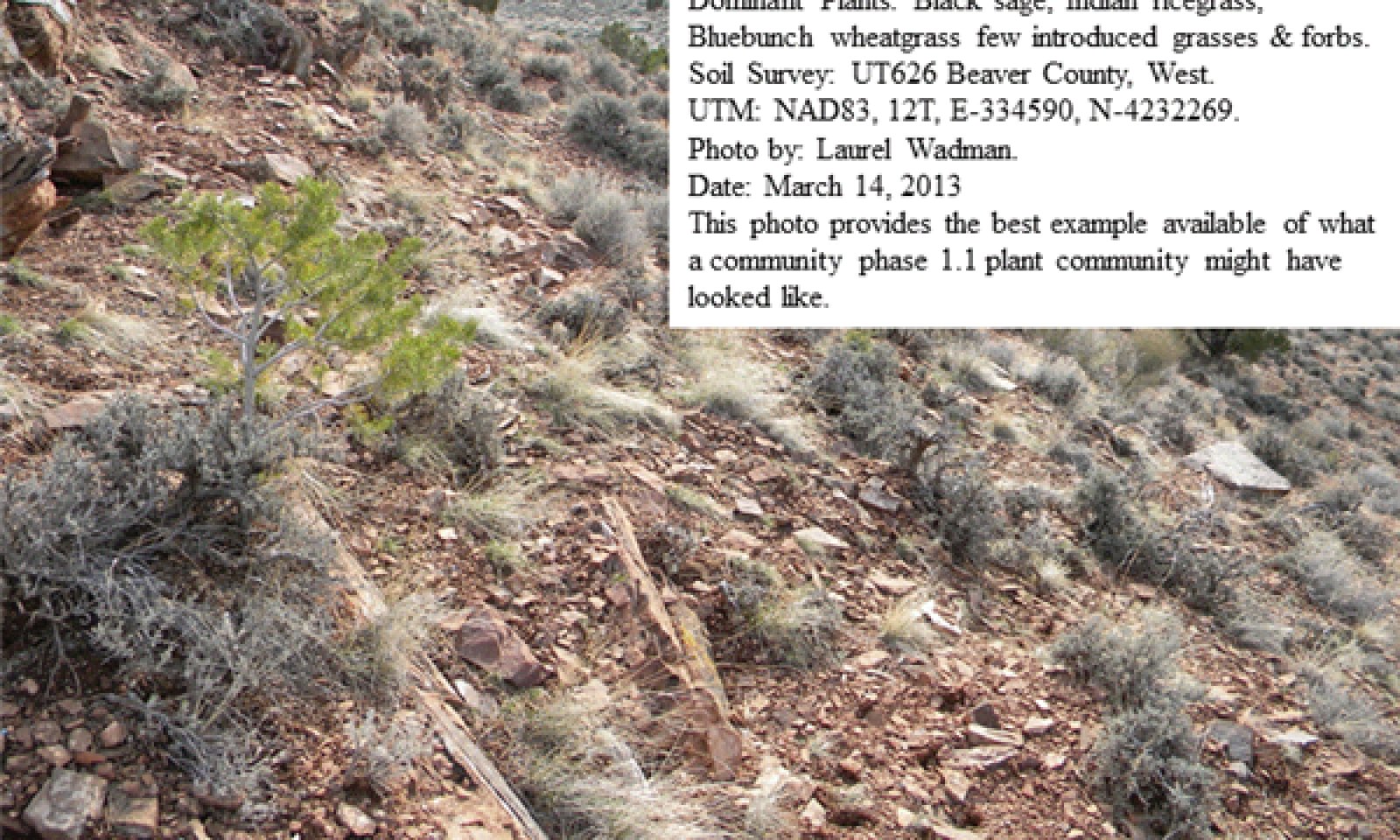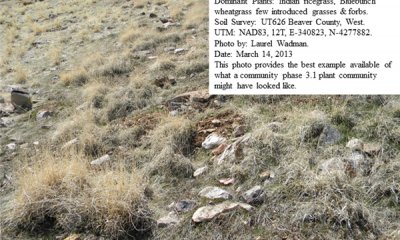
Semidesert Stony Loam (Black Sagebrush)
Scenario model
Current ecosystem state
Select a state
Management practices/drivers
Select a transition or restoration pathway
- Transition T1A More details
- Transition T2A More details
-
No transition or restoration pathway between the selected states has been described
Target ecosystem state
Select a state
Description
This state describes the various biotic communities that are expected to be found on this ecological site under natural conditions. This reference state has a well developed shrub layer with black sagebrush dominating. Nevada ephedra and shadscale are other common shrub species. Bluebunch wheatgrass and Idaho fescue are co-dominant herbaceous species with needle-and-thread and bottlebrush squirreltaik commonly occurring. Other native grasses, forbs, and shrubs will often produce a significant portion of vegetative composition in the plant community.
This site occurs on 1 to 30% slopes on all aspects. It is usually found on fan terraces and remnants, alluvial flats, hills, ridges and mountain slopes. Its' soils are deep, well to excessive well drained and very gravelly or very cobbly sandy loams or loams in texture.
The reference state is self-sustaining and resistant to change due to a good natural resilience to its' natural disturbances. The primary natural disturbance mechanisms are wildlife population densities which can affect the shrub layer composition, weather fluctuations, and fire period.
Definitions:
Reference State: Natural plant communities as influenced by shrub canopy density, long term weather fluctuations, and periodic fire.
Indicators: These communities are dominated by black sagebrush, Idaho fescue and bluebunch wheatgrass. The density of the shrub canopy determines the amount and composition of the other native species present in the community.
Feedbacks: Natural fluctuations in weather patterns that allow for a self-sustaining shrub and native grass community. Prolonged drought, an increase in fire frequency, or other disturbances may allow for the establishment of invasive species.
At-risk Community Phase: All communities are at risk when native plants are stressed and conditions are created that may allow invasive plants to establish.
Trigger: The establishment of invasive plant species.
Submodel
State 2
Current Potential State.




Description
The Current Potential State is similar to the Reference Sate except that non-native species are now present. This state describes the plant communities that may or have become established on this ecological site under various successional sequences and disturbance conditions. This state typically has a well developed shrub layer with black sagebrush often dominating. Shadscale and Nevada ephedra are other common shrub species. Bluebunch wheatgrass and Indian ricegrass are co-dominant herbaceous species with needle-and-thread, Nevada bluegrass and other perennial grasses and forbs commonly found in abundance also. These other native grasses, forbs, and shrubs may produce significant composition in the plant community. Cheatgrass, alyssum, bur buttercup, various mustard species and other non-native species are present on the site and under certain circumstances, may visually dominate the sites aspect.
The primary disturbance mechanisms are livestock grazing, shrub layer density; the amount of invasive species present; weather fluctuations; and fire. The current potential state is still self-sustaining but may be losing its resistance to change due to the impact of disturbances with less resilience following those disturbances.
Definitions:
Current Potential State: Plant communities influenced by shrub canopy density, long term weather fluctuations, grazing and periodic fire. Invasive species are present in various amounts.
Indicators: A community dominated by black sagebrush and perennial grasses. The density of the shrub canopy determines the amount and composition of the other native and introduced grasses and forbs that may be present.
Feedbacks: Natural fluctuations in weather patterns that allow for a self sustaining shrub and native grass community. Prolonged drought, more frequent fires, and/or other disturbances that may allow for the increase of invasive species.
At-risk Community Phase: All communities are at risk when native plants are stressed and nutrients become available for invasive plants to increase.
Trigger: A reduction of perennial grass and forb species combined with an increase of invasive plant species.
Submodel
Description
This state describes plant community phases that have been mechanically treated to remove black sagebrush an/or Utah juniper. Common treatment methods include sagebrush spraying, brush-beating, and where juniper invasion has occurred, chaining. These treated pastures are then typically seeded to introduced forage species such as intermediate or crested wheatgrass, or managed to allow native perennial grasses to recover. Invasive weedy species, including cheatgrass, halogeton, alyssum, bur buttercup, various mustard species and other non-native species, are present and, in some cares, may visually dominate the sites herbaceous layer. On pastures where seedings fail or native species do not respond to management, the site is often covered with annuals which can prevent site recovery and may periodically burn and re-burn.
The primary disturbance mechanisms include; the amount of of invasive herbaceous species present; weather fluctuations, and fire patterns. This state may have lost its resistance to change due to the impact of these disturbances and has less resilience following those disturbances.
Definitions:
Mechanically Altered State: Plant communities that have been manipulated to remove black sagebrush and/or Utah juniper; long term weather fluctuations; and periodic fire.
Indicators: The composition of the herbaceous community determines any additional treatment needs including range seeding and/or proper grazing management to allow native and introduced grasses and forbs to recover.
Feedbacks: Natural fluctuations in weather patterns that impact herbaceous communities. Prolonged drought, less frequent fire, and/or other disturbances that allow for the increase of all invasive species.
At-risk Community Phase: All communities are at risk when native plants are stressed and nutrients become available for invasive plants to increase.
Trigger: A reduction of perennial grass and forb species combined with an increase of invasive plant species.
Submodel
Mechanism
This transitional pathway occurs when any combination of improper livestock grazing, prolonged drought or other disturbance causes the perennial herbaceous community to become significantly reduced allowing non-native species such as cheatgrass, halogeton, alyssum, Russian thistle and other invasive weeds to become established. Broom snakeweed may also increase during this time. Once invasive species occupy the site, a threshold has been crossed. Cheatgrass, however, has been known to become established in healthy communities on this site.
Mechanism
This transitional pathway occurs when the site is sprayed, brush beat, or disked to remove black sagebrush and other unwanted shrubs. Where Utah juniper has invaded, chaining has been completed. The perennial herbaceous community may respond positively to this treatment if proper management is applied. Where insufficient desirable forage species are not available, introduced species are seeded onto the site. Non-native species such as cheatgrass, halogeton, alyssum, Russian thistle and other invasive weeds are also present. Broom snakeweed may also increase during this time.
Model keys
Briefcase
Add ecological sites and Major Land Resource Areas to your briefcase by clicking on the briefcase (![]() ) icon wherever it occurs. Drag and drop items to reorder. Cookies are used to store briefcase items between browsing sessions. Because of this, the number of items that can be added to your briefcase is limited, and briefcase items added on one device and browser cannot be accessed from another device or browser. Users who do not wish to place cookies on their devices should not use the briefcase tool. Briefcase cookies serve no other purpose than described here and are deleted whenever browsing history is cleared.
) icon wherever it occurs. Drag and drop items to reorder. Cookies are used to store briefcase items between browsing sessions. Because of this, the number of items that can be added to your briefcase is limited, and briefcase items added on one device and browser cannot be accessed from another device or browser. Users who do not wish to place cookies on their devices should not use the briefcase tool. Briefcase cookies serve no other purpose than described here and are deleted whenever browsing history is cleared.
Ecological sites
Major Land Resource Areas
The Ecosystem Dynamics Interpretive Tool is an information system framework developed by the USDA-ARS Jornada Experimental Range, USDA Natural Resources Conservation Service, and New Mexico State University.







